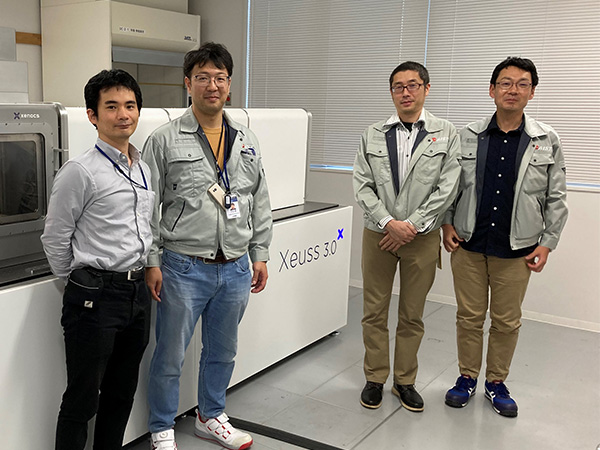A Xeuss 3.0 Small Angle X-Ray Scattering (SAXS) and Wide Angle X-Ray Scattering instrument was installed six months ago at the Chugoku center of the National Institute of Advanced Industrial Science and Technology (AIST) in Hiroshima, Japan.
In this article, AIST researchers Dr. Watanabe, Dr. Sakakibara, Dr. Inutsuka and Dr. Nakayama, who are the main users of the instrument, share with us how SAXS and WAXS are used at AIST, and why they have invested in a Xeuss 3.0 SAXS WAXS instrument for their center.
The Xeuss SAXS/WAXS instrument is used at AIST for several research applications

From left to right: Dr Inutsuka, Dr. Nakayama, Dr. Watanabe and Dr. Sakakibara
Two groups led respectively by Dr Watanabe – Senior Researcher from the Organic Materials Diagnosis Group, and Dr Sakakibara – leader of the Cellulose Materials Group, use the equipment on a daily basis.
The Organic Materials Diagnosis Group focus on studying the structural properties of polymers. SAXS and WAXS techniques are used to analyze the formation of structures in polymer materials. “We use SAXS to get information on the structure of samples, such as the thickness of the lamellar structure, and in the WAXS region we study the crystallinity of polymers. We also extend the range of measurements to a few micrometers with USAXS”, explains Dr Watanabe.
The Cellulose Materials Group conducts the fundamental and applied research on the preparation and utilization of cellulosic materials. In particular, nanocelluloses, obtained from natural sources such as wood biomass, are extensively studied by focusing on the nanofibrillation technique, molecular-based precise analysis, and composite preparation for industrial use, i.e., nanocellulose-reinforced resins and rubber. “We investigate the nano-to-meso structure and dynamics of cellulosic composite materials by SAXS/WAXS, allowing us to understand the structure/properties relationship and then to design high-performance composite materials”, explains Dr. Sakakibara.
The team also study polymer degradation. Dr. Nakayama explains: “We use SAXS and WAXS to study the higher-order structure of polymers during processes like polymer degradation and stability testing”.
Contributing to industries to address their current challenges
Still, the instrument is not limited to internal researchers at AIST; it is also used for industrial and academic partners with AIST. In the Research Institute for Sustainable Chemistry, where Dr. Watanabe is Senior Researcher, the focus extends beyond individual research and development efforts. The division plays a pivotal role in AIST’s innovation creation function by collaborating closely with companies to address their current challenges, acting as a facilitator and supporter.
“Here at AIST, we place a strong emphasis on addressing real-world issues rather than solely concentrating on our own research tasks’, Dr Watanabe explains. “The Xeuss 3.0 SAXS/WAXS instrument enables comprehensive material analysis. We expect the instrument to contribute to resolving social issues and improving industrial competitiveness.”
Many of the challenges faced by industries can be effectively tackled by thoroughly analyzing materials from various perspectives and establishing connections between structural information (ranging from molecular to higher-order and interface), and material properties (such as mechanical properties, functionality, etc.).
In this context, the Xeuss 3.0 from Xenocs is recognized by AIST as a strategic tool for acquiring crucial structural information required to overcome these challenges.
Enhancing research and productivity
Screening and Productivity Enhancement – The Xeuss instrument is used on a daily basis at AIST. When higher beam intensity is required, the instrument is used for initial screening of samples before resorting to synchrotron facilities. This improves research productivity, as the teams can gather preliminary SAXS information in the lab, and therefore optimize their synchrotron beamtime.
“We use the Xeuss even before going to a synchrotron. Having prior knowledge on the samples using the Xeuss instrument saves us time and money”, Dr Sakakibara says.
Complementary Techniques – The Xeuss instrument is used in conjunction with other techniques such as TEM, SEM, AFM, X-ray CT, and rheology, depending on the size of the objects being investigated. The combination of techniques enhances the understanding of materials spanning from very small molecules to larger objects.
Why AIST chose the Xeuss
There were several reasons why the Xeuss from Xenocs was selected specifically.
Imaging and Scattering: “We really like the InXight Imaging Module. This option enables us to run both X-ray imaging and X-ray scattering measurements. With InXight, we can locate a point of interest which we then further study with SAXS & WAXS”.
Ease of Use and Software: “The software for measurement and data analysis is very good and user-friendly, even for those unfamiliar with SAXS and WAXS. Since our equipment is open to industrial customers who are not always familiar with SAXS and WAXS, this is a big advantage. External and non-expert users become autonomous using the instrument just after one or two-hour training.”
Sample Holders and Environments: “The instrument offers a variety of sample holders and environments, such as a temperature stage which we use a lot. The large sample chamber volume allows for potential integration of other environments in the future”.
No Beam stop: “We like the absence of a beamstop on the Xeuss 3.0. This reduces the risk of damage and potential downtime, leading to improved productivity”.
Modularity: “We also like the moving WAXS, the wide range of sample-to-detector distance, and the USAXS module which is very useful for measurements of big molecules”.
Services: “Lastly, I can say that the training we received on the equipment was really good, clear and detailed. We have been able to use the instrument for our research right after being trained”.
About AIST
The National Institute of Advanced Industrial Science and Technology (AIST), one of the largest public research organizations in Japan, focuses on the creation and practical realization of technologies useful to Japanese industry and society, and on “bridging” the gap between innovative technological seeds and commercialization.
































